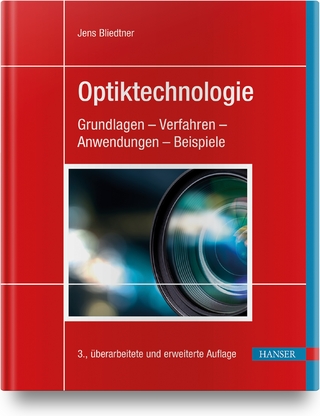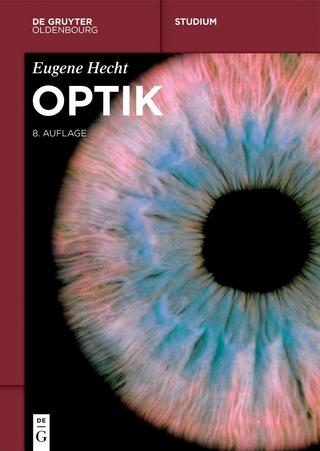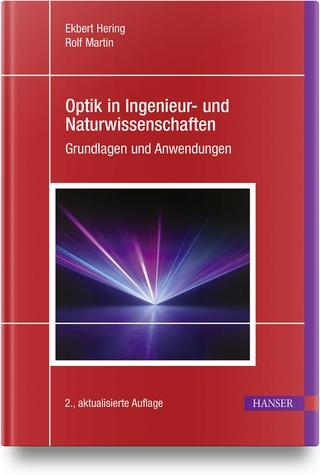
Principles of Lasers
Kluwer Academic/Plenum Publishers (Verlag)
978-0-306-40862-5 (ISBN)
- Titel ist leider vergriffen;
keine Neuauflage - Artikel merken
Thus a few topics have been moved from one section to another and a new chapter entitled Laser Beam Transformation has been added. (iii) To further reduce the mathematical content, placing greater emphasis on physical descrip- tions of phenomena.
1 Introductory Concepts.- 1.1 Spontaneous and Stimulated Emission, Absorption.- 1.1.1 Spontaneous Emission.- 1.1.2 Stimulated Emission.- 1.1.3 Absorption.- 1.2 The Laser Idea.- 1.3 Pumping Schemes.- 1.4 Properties of Laser Beams.- 1.4.1 Monochromaticity.- 1.4.2 Coherence.- 1.4.3 Directionality.- 1.4.4 Brightness.- Problems.- 2 Interaction of Radiation with Matter.- 2.1 Summary of Blackbody Radiation Theory.- 2.2 Absorption and Stimulated Emission.- 2.2.1 Rates of Absorption and Stimulated Emission.- 2.2.2 Allowed and Forbidden Transitions.- 2.2.3 Transition Cross Section, Absorption and Gain Coefficient.- 2.3 Spontaneous Emission.- 2.3.1 Semiclassical Approach.- 2.3.2 Quantum Electrodynamic Approach.- 2.3.3 Einstein Thermodynamic Treatment.- 2.3.4 Radiation Trapping, Superradiance, Superfluorescence, and Amplified Spontaneous Emission.- 2.4 Nonradiative Decay.- 2.5 Line Broadening Mechanisms.- 2.5.1 Homogeneous Broadening.- 2.5.2 Inhomogeneous Broadening.- 2.5.3 Combined Effect of Line Broadening Mechanisms.- 2.6 Saturation.- 2.6.1 Saturation of Absorption: Homogeneous Line.- 2.6.2 Gain Saturation: Homogeneous Line.- 2.6.3 Inhomogeneously Broadened Line.- 2.7 Degenerate Levels.- 2.8 Relation between Cross Section and Spontaneous Radiative Lifetime.- 2.9 Molecular Systems.- 2.9.1 Energy Levels of a Molecule.- 2.9.2 Level Occupation at Thermal Equilibrium.- 2.9.3 Radiative and Nonradiative Transitions.- Problems.- References.- 3 Pumping Processes.- 3.1 Introduction.- 3.2 Optical Pumping.- 3.2.1 Pumping Efficiency.- 3.2.2 Pump Light Distribution.- 3.2.3 Pumping Rate.- 3.3 Electrical Pumping.- 3.3.1 Electron Impact Excitation.- 3.3.2 Spatial Distribution of the Pump Rate.- 3.3.3 Pumping Efficiency.- 3.3.4 Excitation by (Near) Resonant Energy Transfer.- Problems.- References.- 4 Passive Optical Resonators.- 4.1 Introduction.- 4.2 Plane-Parallel Resonator.- 4.2.1 Approximate Treatment of Schawlow and Townes.- 4.2.2 Fox and Li Treatment.- 4.3 Confocal Resonator.- 4.4 Generalized Spherical Resonator.- 4.4.1 Mode Amplitudes, Diffraction Losses, and Resonance Frequencies.- 4.4.2 Stability Condition.- 4.5 Unstable Resonators.- Problems.- References.- 5 Continuous Wave and Transient Laser Behavior.- 5.1 Introduction.- 5.2 Rate Equations.- 5.2.1 Four-Level Laser.- 5.2.2 Three-Level Laser.- 5.3 CW Laser Behavior.- 5.3.1 Four-Level Laser.- 5.3.2 Three-Level Laser.- 5.3.3 Optimum Output Coupling.- 5.3.4 Reasons for Multimode Oscillation.- 5.3.5 Single-Line and Single-Mode Oscillation.- 5.3.6 Two Numerical Examples.- 5.3.7 Frequency Pulling and Limit to Monochromaticity.- 5.3.8 Lamb Dip and Active Stabilization of Laser Frequency.- 5.4 Transient Laser Behavior.- 5.4.1 Spiking Behavior of Single-Mode and Multimode Lasers.- 5.4.2 Q-Switching.- 5.4.2.1 Methods of Q-Switching.- 5.4.2.2 Operating Regimes.- 5.4.2.3 Theory of Q-Switching.- 5.4.2.4 A Numerical Example.- 5.4.3 Mode Locking.- 5.4.3.1 Methods of Mode Locking.- 5.4.3.2 Operating Regimes.- 5 5 Limits to the Rate Equations.- Problems.- References.- 6 Types of Lasers.- 6.1 Introduction.- 6.2 Solid-State Lasers.- 6.2.1 The Ruby Laser.- 6.2.2 Neodymium Lasers.- 6.3 Gas Lasers.- 6.3.1 Neutral Atom Lasers.- 6.3.2 Ion Lasers.- 6.3.2.1 Ion Gas Lasers.- 6.3.2.2 Metal Vapor Lasers.- 6.3.3 Molecular Gas Lasers.- 6.3.3.1 Vibrational-Rotational Lasers.- 6.3.3.2 Vibronic Lasers.- 6.3.3.3 Excimer Lasers.- 6.4 Liquid Lasers (Dye Lasers).- 6.4.1 Photophysical Properties of Organic Dyes.- 6.4.2 Characteristics of Dye Lasers.- 6.5 Chemical Lasers.- 6.6 Semiconductor Lasers.- 6.6.1 Photophysical Properties of Semiconductor Lasers.- 6.6.2 Characteristics of Semiconductor Lasers.- 6.7 Color-Center Lasers.- 6.8 The Free-Electron Laser.- 6.9 Summary of Performance Data.- Problems.- References.- 7 Properties of Laser Beams.- 7.1 Introduction.- 7.2 Monochromaticity.- 7.3 First-Order Coherence.- 7.3.1 Complex Representation of Polychromatic Fields.- 7.3.2 Degree of Spatial and Temporal Coherence.- 7.3.3 Measurement of Spatial and Temporal Coherence.- 7.3.4 Relation between Temporal Coherence and Monochromaticity.- 7.3.5 Some Numerical Examples.- 7.4 Directionality.- 7.5 Laser Speckle.- 7.6 Brightness.- 7.7 Higher-Order Coherence.- Problems.- References.- 8 Laser Beam Transformation.- 8.1 Introduction.- 8.2 Transformation in Space. Gaussian Beam Propagation.- 8.3 Transformation in Amplitude: Laser Amplification.- 8.4 Transformation in Frequency: Second-Harmonic Generation and Parametric Oscillation.- 8.4.1 Physical Picture.- 8.4.1.1 Second-Harmonic Generation.- 8.4.1.2 Parametric Oscillation.- 8.4.2 Analytical Treatment.- 8.4.2.1 Parametric Oscillation.- 8.4.2.2 Second-Harmonic Generation.- Problems.- References.- 9 Applications of Lasers.- 9.1 Introduction.- 9.2 Applications in Physics and Chemistry.- 9.3 Applications in Biology and Medicine.- 9.4 Material Working.- 9.5 Optical Communications.- 9.6 Measurement and Inspection.- 9.7 Thermonuclear Fusion.- 9.8 Information Processing and Recording.- 9.9 Military Applications.- 9.10 Holography.- 9.11 Concluding Remarks.- References.- Appendixes.- A Space-Dependent Rate Equations.- B Physical Constants.- Answers to Selected Problems.
| Erscheint lt. Verlag | 31.12.1995 |
|---|---|
| Zusatzinfo | biography |
| Sprache | englisch |
| Themenwelt | Naturwissenschaften ► Physik / Astronomie ► Optik |
| Naturwissenschaften ► Physik / Astronomie ► Quantenphysik | |
| Technik | |
| ISBN-10 | 0-306-40862-7 / 0306408627 |
| ISBN-13 | 978-0-306-40862-5 / 9780306408625 |
| Zustand | Neuware |
| Haben Sie eine Frage zum Produkt? |
aus dem Bereich


